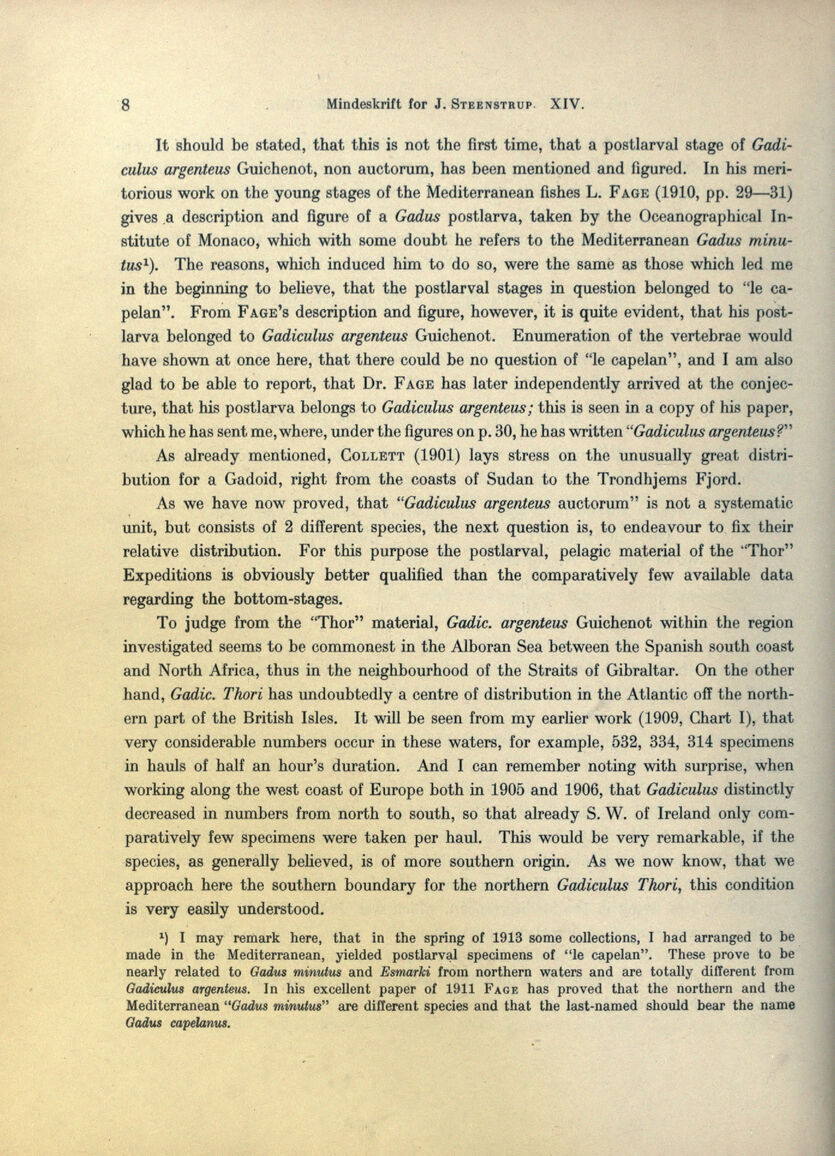
Full resolution (JPEG) - On this page / på denna sida - Gadiculus Argenteus and Gadiculus Thori

<< prev. page << föreg. sida << >> nästa sida >> next page >>
Below is the raw OCR text
from the above scanned image.
Do you see an error? Proofread the page now!
Här nedan syns maskintolkade texten från faksimilbilden ovan.
Ser du något fel? Korrekturläs sidan nu!
This page has been proofread at least once.
(diff)
(history)
Denna sida har korrekturlästs minst en gång.
(skillnad)
(historik)
It should be stated, that this is not the first time, that a postlarval stage of
Gadiculus argenteus Guichenot, non auctorum, has been mentioned and figured. In his
meritorious work on the young stages of the Mediterranean fishes L. Fage (1910, pp. 29—31)
gives a description and figure of a Gadus postlarva, taken by the Oceanographical
Institute of Monaco, which with some doubt he refers to the Mediterranean Gadus
minutus[1]. The reasons, which induced him to do so, were the same as those which led me
in the beginning to believe, that the postlarval stages in question belonged to “le
capelan”. From Fage’s description and figure, however, it is quite evident, that his
postlarva belonged to Gadiculus argenteus Guichenot. Enumeration of the vertebrae would
have shown at once here, that there could be no question of “le capelan”, and I am also
glad to be able to report, that Dr. Fage has later independently arrived at the
conjecture, that his postlarva belongs to Gadiculus argenteus; this is seen in a copy of his paper,
which he has sent me, where, under the figures on p. 30, he has written “Gadiculus argenteus?”
As already mentioned, Collett (1901) lays stress on the unusually great
distribution for a Gadoid, right from the coasts of Sudan to the Trondhjems Fjord.
As we have now proved, that “Gadiculus argenteus auctorum” is not a systematic
unit, but consists of 2 different species, the next question is, to endeavour to fix their
relative distribution. For this purpose the postlarval, pelagic material of the “Thor”
Expeditions is obviously better qualified than the comparatively few available data
regarding the bottom-stages.
To judge from the “Thor” material, Gadic. argenteus Guichenot within the region
investigated seems to be commonest in the Alboran Sea between the Spanish south coast
and North Africa, thus in the neighbourhood of the Straits of Gibraltar. On the other
hand, Gadic. Thori has undoubtedly a centre of distribution in the Atlantic off the
northern part of the British Isles. It will be seen from my earlier work (1909, Chart I), that
very considerable numbers occur in these waters, for example, 532, 334, 314 specimens
in hauls of half an hour’s duration. And I can remember noting with surprise, when
working along the west coast of Europe both in 1905 and 1906, that Gadiculus distinctly
decreased in numbers from north to south, so that already S. W. of Ireland only
comparatively few specimens were taken per haul. This would be very remarkable, if the
species, as generally believed, is of more southern origin. As we now know, that we
approach here the southern boundary for the northern Gadiculus Thori, this condition
is very easily understood.
<< prev. page << föreg. sida << >> nästa sida >> next page >>